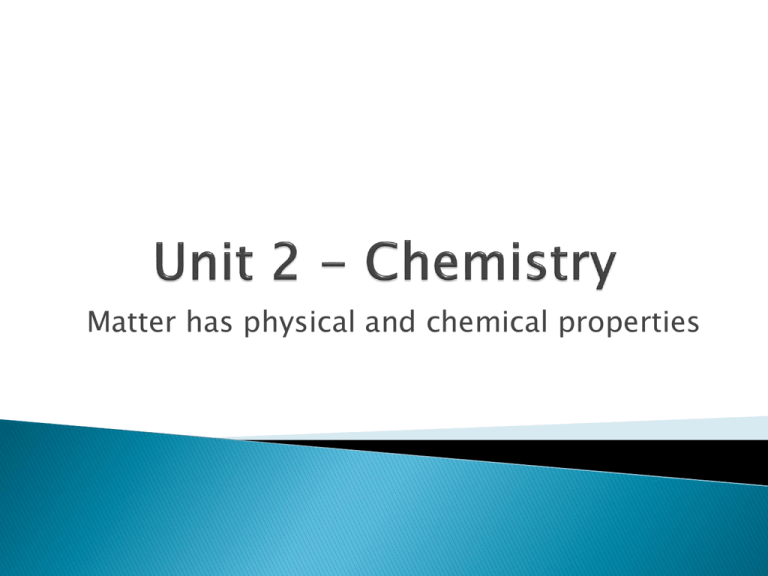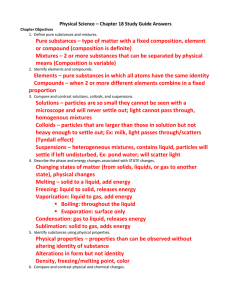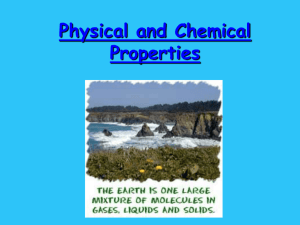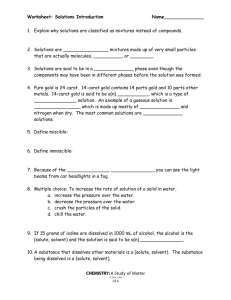Unit 2 - Chemistry
advertisement

Matter has physical and chemical properties Matter is anything that has mass and volume ◦ Mass is the amount of matter in an object, often measured in grams or kilograms ◦ Volume is the amount of space an object takes up (both solids and fluids), often measured in millilitres or litres A volleyball or a shot put ball? ◦ Mass? ◦ Volume? Matter can be solid, liquid, or gas, or a combination of these states. Example, bubbles are both liquid and gas. Solids, liquids, and gases are called states of matter. Melting – a change from a solid to a liquid ◦ Example: an ice cube melting Evaporation – a change from a liquid to a gas (also called vapourization) ◦ Example: water boiling creating steam Condensation - A change from a gas to a liquid ◦ Example: steam from the shower forming water droplets on the mirror Freezing – A change from a liquid to a solid ◦ Example: Water freezing into ice Sublimation – A change from solid directly into a gas ◦ Example: dry ice ‘smoking’ Deposition – A change from gas directly into solid ◦ Example: Snow! Clouds become a solid (snow) without becoming water (rain) first The temperature at which a solid turns into a liquid is called the melting point. For example, the melting point of water is 0°C. The temperature at which a liquid turns into a solid is called the freezing point. For example, the freezing point of water is 0°C. (Notice these are the same, they are always the same temperature). The temperature in which a liquid turns to a gas is called the boiling point. For water this is 100°C. Is a way to describe the structure of matter and its behaviour. Matter can be broken into smaller and smaller pieces until it’s the smallest possible piece, called a particle. There are 4 parts to the theory… 1. All matter is composed of very tiny objects called particles ◦ These particles are too small to be seen, even with a microscope. 2. All particles have space between them ◦ These distances change for the different states of matter (solid, liquid, gas) 3. Particles present in matter are always in motion ◦ In solids they vibrate back and forth ◦ In a gas they move in all directions ◦ In a liquid particles slide past one another, but stay close together. 4. The particles in a substance attract each other ◦ Why can you stand on concrete and not on water? http://www.harcourtschool.com/activity/states_of_matter/mole cules.swf All matter is made up of different types or combinations of particles. Different types and combinations of particles give every type of matter particular characteristics, or properties. A property is a characteristic that describes a substance (ex: colour, temperature, state, smell, etc). Substances may be classified as pure substances or as mixtures. are made up of only one kind of matter (for example, pure water) are either an element or a compound (example: gold is an element, sugar is a compound) ◦ An element is found on the periodic table of elements (like sodium) ◦ A compound is a combination of two or more elements that are combined chemically (like salt) Have a unique set of properties, such as colour, hardness, boiling point, melting point. What are some properties of water? Is water an element or a compound? A mixture is a combination of pure substances, but the substances are not combined chemically There are 3 main type of mixtures: mechanical mixture, suspension, and solution The different substances are visible. Examples: soil, seasoning salt When the different parts are visible it’s called heterogeneous (parts look different) Are a cloudy mixture in which tiny particles of one substance are held within another Examples: tomato juice, salad dressing that is shaken Suspensions are also heterogeneous The different substances that make it up are not individually visible, one substance is dissolved in the other. These are homogeneous mixtures (all parts look the same) Examples: sugar dissolved in coffee, salt dissolved in water







